Fashion History Lesson: The Evolution and Importance of the First Lady's Style
Today, the first lady is a celebrity in her own right, and with that comes widespread interest in her clothing choices. Plus, with the 2020 election on the horizon, how might we treat first gentleman fashion?
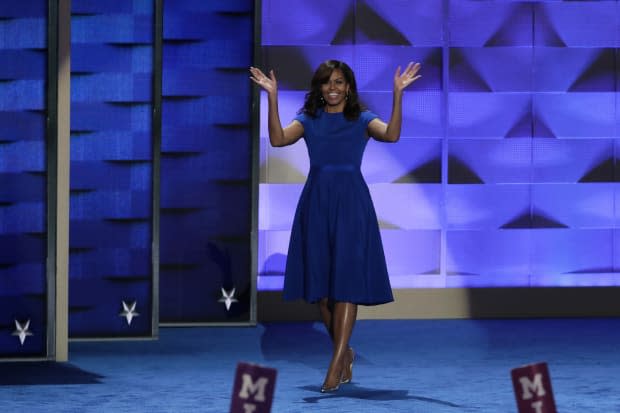
Welcome to Fashion History Lesson, in which we dive deep into the origin and evolution of the fashion industry's most influential and omnipresent businesses, icons, trends and more.
The first lady of the United States holds a peculiar role in U.S. politics: She is not an elected leader and has no official duties, but whomever is in the role never fails to command the public's attention. These women are thrust into the spotlight not by choice, but simply because of their husbands' ambitions. They are then expected to represent the country at home and abroad.
Today, the first lady is a celebrity in her own right, and with that stardom comes interest in her clothing, appearance and actions. Fashion can be a powerful tool for someone in the public eye to communicate and relate to a broad audience, and when successful, a first lady can use the interest in her clothes to her advantage. Think of all the times Michelle Obama championed American designers, while others stumble finding their place in the canon of fashion history; see: Melania Trump's infamous jacket. First ladies have been the subject of numerous wardrobe "scandals," too, like Pat Nixon wearing pants or Hillary Clinton's cold shoulders. It can be a difficult task for a first lady to mitigate expectations about her wardrobe on top of other duties, but fashion is also an important way for the first lady to connect with people. And whether thought to be warranted or not, the American public will always seem to notice what the first lady is wearing.
Related Articles
Fashion History Lesson: Celebrity Clothing Lines Date Back to the 1800s
Fashion History Lesson: How Halston, Levi Strauss and Ralph Lauren Changed Olympic Uniforms
Fashion History Lesson: The Boozy Evolution of the Cocktail Dress
First Ladies in History
Since the beginning of the first ladyship, the wife of the United States president has been one of the most well-known women of her time. The very first First Lady, Martha Washington (1731-1802), was a visible symbol of her husband's presidency and of the new country. [1] This recognition of first ladies only continued to grow as the role evolved and these women took on more responsibility, serving as an official White House hostess, acting as the president's confidante and sometimes even having a hand in policy.
Dolley Madison (1768-1849) had a tremendous impact on her husband's administration, not just because he valued her political acumen, but also because she worked to create a public image as a fashionable woman and a consummate White House host. She dressed extravagantly for some events but knew when to scale it back so as not to overshadow her husband. She was known for wearing turbans with empire-cut gowns from Paris. Her reputation for being stylish set the standard for what a first lady of a young new country should be and how her fashion and image related to her husband's presidency. By wearing dresses that were reminiscent of the Greek republic, she was reminding people of the ideals America represented. This use of clothing as symbolism would inform first ladies to come, including Michelle Obama.
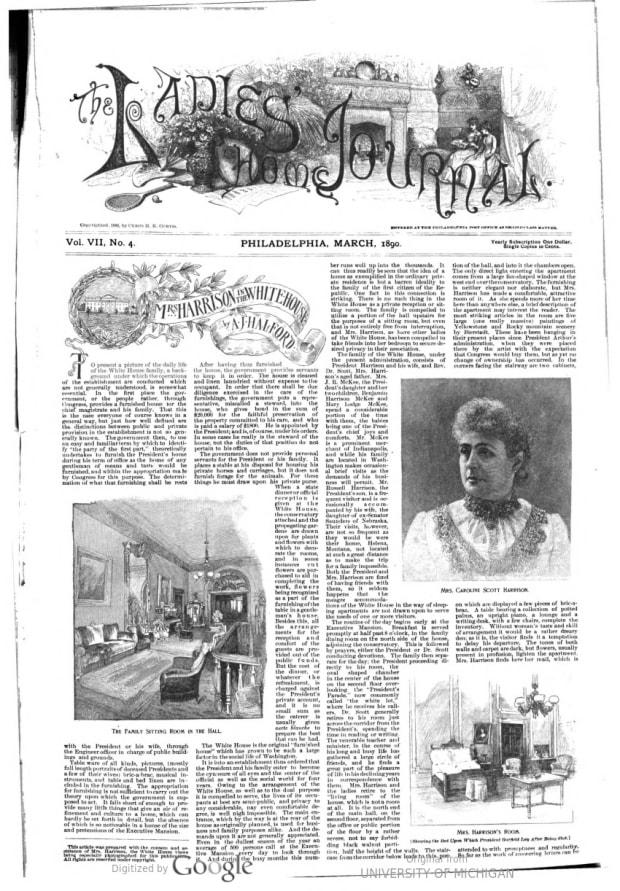
Due to a growing media culture and accessibility to images and information relating to the president and first family, first ladies were increasingly expected to fill many capacities, including celebrity and role model. Coverage in newspapers and magazines allowed the public to follow first ladies' lives and documented their interests and fashions, as Vogue and other publications do to this day. Ladies' Home Journal, a women's magazine first published in 1883, frequently covered first ladies with a feature article and accompanying images. As early as 1890, then-First Lady Caroline Scott Harrison's (1832-1892) portrait appeared on the front page of the March issue of the magazine along with interior views of the White House. The article, "Mrs. Harrison in the White House," outlines a day in the home life of the first lady, giving the public insight to a fabled home and its occupants.
A few years later in January 1898, First Lady Ida Saxton McKinley (1847-1907) appeared on the publication's cover, marking the first time the magazine's front page featured a photograph rather than an illustration. There was no accompanying article on her life in the White House or the fashions she wore; instead, the magazine published sheet music for a song written by John Philip Sousa entitled "The Lady of The White House." The fact that the magazine chose to feature a photograph of the first lady speaks to the visual power and influence of the woman and her role. Ladies' Home Journal continued to feature first ladies as "cover girls" for years to come, until it stopped publishing monthly in 2014.
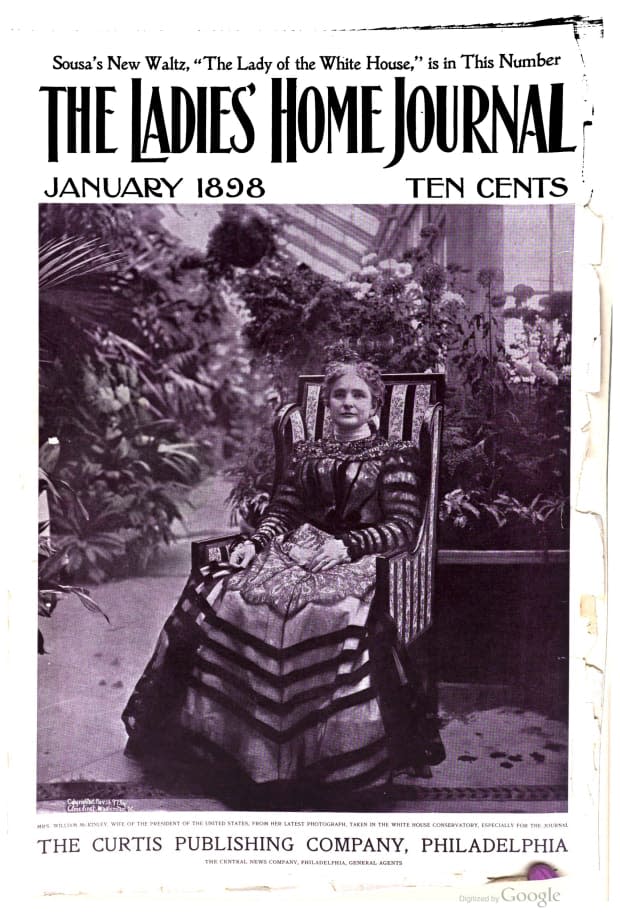
When Grover Cleveland (1837-1908) was running for reelection in 1888, his young wife Frances Folsom Cleveland (1864-1947) used her reputation as an attractive and fashionable woman to campaign for him. [2] She was dubbed the "first celebrity first lady" by some sources, which was a boon to her husband not just because she was stylish but because of the perceived positive influence she had on her husband. Magazines and newspapers covered her wardrobe with great interest, including the ivory satin wedding gown by Maison Worth that she wore to marry President Cleveland in a White House ceremony during his first term. Though not successful in the election of 1888, the Clevelands returned to the White House in 1892 for a second term, and Cleveland continued to be a fashion leader for women of her time.
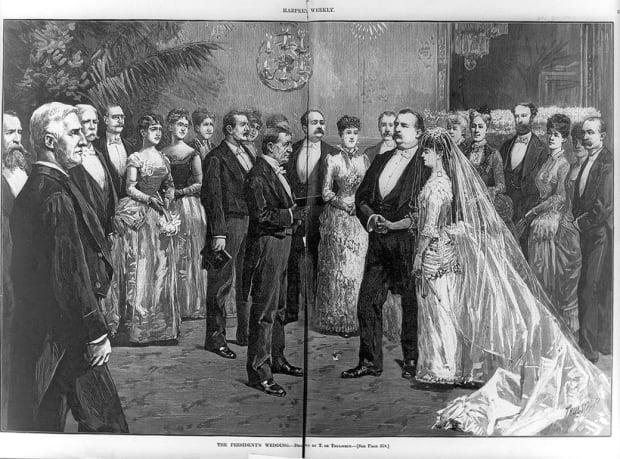
Modern First Ladies
By the 20th century, the first lady had acquired White House staff and was an integral and influential political asset to her husband, both as a private aid and a public figure. [1] Appearing in the press and along the campaign trail is now a vital part of a first lady's role as an indispensable asset to her husband, so her appearance and image was hugely important. By the 1950s, a candidate's wife was a key way to capture the female vote that had grown to make up half of the electorate. [2] Harper’s Bazaar published an article in November 1960 called "The First Lady," in which it considered the styles and physical appearance of the wives of the two presidential candidates: Jacqueline Kennedy and Patricia Nixon. Author Keith Kyle wrote, "One can only guess how much the women [voters] [...] will be influenced by thought of the contrasting style of the two potential First Ladies. Mrs. Kennedy's chic and Mrs. Nixon's commonsensical manner may be electorally important not so much because of the type of social regime they portend for the White House as because of what they may be thought to tell about the personalities of their husbands."
The appearance and dress of first ladies are important factors when attempting to harness a first lady's political potential, and that has been increasingly true since the election of 1960. Not only did the Richard Nixon-John F. Kennedy election usher in a new age of presidential campaigning [3], but it also marked the start of the "modern" first ladies when Jacqueline Kennedy entered the limelight. [4] Life magazine wrote of the Kennedy campaign, "The candidate's striking wife Jackie, who sticks close to her husband, has attracted almost as much attention as he has. Women crane to see what she is wearing. Voters of both sexes bombard her with questions, many of them curiously unpolitical … the kind of questions usually put to a Hollywood movie queen." [5] Jacqueline Kennedy catapulted the role of first lady into automatic celebrity.
When the Kennedys entered the White House, Jacqueline was the third-youngest first lady in United States history at 31 years old and was well-liked by the public in America and abroad. She was knowledgeable about the arts, including fashion, and spoke several languages. She didn't have the privacy of her predecessors who served in pre-television times. This, combined with the media attention paid to her and her family, meant the public had unprecedented access to her as a celebrity figure. All of these factors contributed to her reputation for being able to appeal to a wide audience and this image would come to shape what the American public would expect from the first lady going forward.
Michelle Obama is the first lady who most closely rivals Kennedy's reputation as a style icon. Both women captured America's interest with their likability and appearance. Each thought about how their wardrobe would look to a national audience and made intentional choices to avoid critical backlash, as many first ladies have also done. While Kennedy and Obama do share some important traits, including a penchant for sleeveless dresses, the pair's wardrobe differed in accessibility and approach. Kennedy's wardrobe was based on Paris fashions of the time. She patronized couture houses like Givenchy and Chanel, often choosing skirt suits (with a pillbox hat!) and shift dresses for daytime. The most memorable of these is the pink Chanel-inspired suit she was wearing the day her husband was shot in 1963.
However, Kennedy received criticism during her husband's campaign for not buying clothes by American designers. In response, Kennedy reached out to then-Harper’s Bazaar fashion editor Diana Vreeland for clothing advice, citing the need to buy her clothes domestically. She ended up choosing Oleg Cassini to create her White House wardrobe, including the gown she wore to the 1962 inauguration. Kennedy continued to buy couture in addition to American-made versions of Paris models from department stores, which American ready-to-wear retailers would then copy and promote as the "Jackie Look." [5] The American consumer looking to dress in Kennedy's image would be buying a garment that had been filtered through the fashion system. It was impossible to participate directly in her style without also being able to buy Parisian couture clothes, a luxury few Americans could afford.
On the other hand, Obama's style has always been accessible and genuine, which adds to her appeal. In October 2008, she went on Jay Leno's late-night talk show right after the news broke that the Republican Party had spent $150,000 for vice-presidential nominee Sarah Palin's wardrobe. Obama did the appearance wearing J. Crew that she had bought online, solidifying her reputation as being approachable and down-to-earth. This reputation would follow her through her eight years as FLOTUS. Even when she did wear expensive labels, she did so in a way that promoted inclusivity by using her platform to bring attention to then-unknown designers like Jason Wu or Prabal Gurung, which had a huge impact on their careers. She still wore tried-and-true first lady staples like Oscar de la Renta and Carolina Herrera, but she also promoted diversity through her wardrobe by mixing up the designers and brands she wore rather than working with a select few.
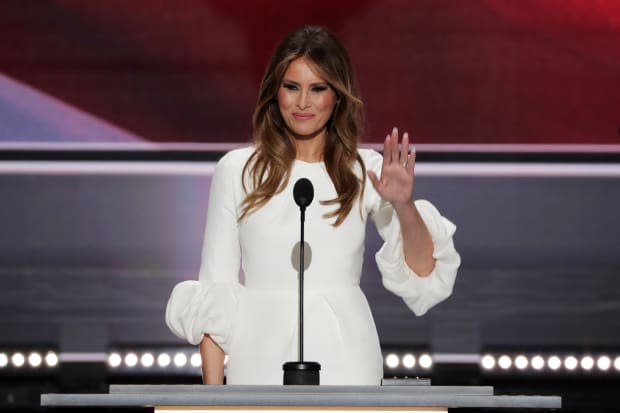
As for current First Lady Melania Trump, it's still too soon to decide how her fashion will be remembered. As it is, her choices seem to draw from her time as a model. She sticks to favorites like Dolce & Gabbana or Ralph Lauren. She tends to make obvious references through her wardrobe (such as when she channeled Jackie Kennedy at the 2017 inauguration or wore a safari outfit in Kenya). She usually looks very put-together, but her choices lack the personality that has characterized the tenure of so many of her predecessors. She is not immune to the criticism and pressure that all first ladies have faced, both in terms of fashion and beyond, and at times this seems to make her withdraw, to dress to blend in rather than to speak out.
What's perhaps more interesting to think about, with the 2020 election on the horizon, is: How will we treat first gentleman fashion? The public cares about how men present themselves, too, otherwise there wouldn't have been so much attention drawn to Barack Obama's tan suit or Donald Trump's ill-fitting tuxedo. In fact, in 2016, there was already a good bit of talk about the chance of Bill Clinton being the first-ever first gentleman. If a woman (or Pete Buttigieg) wins in 2020, will the first gentleman dress with subtlety to focus attention on the president? Or will he use his platform to elevate men's fashion? Will he look abroad or to local government to see how other political husbands have handled this issue? No matter what, the role of first gentleman will have to go through a lot of growing pains, of which fashion diplomacy will only be one part, but it would be fun to see how a man in 2020 would carry on the traditions of our beloved first ladies.
Sources Not Linked:
[1] Anthony J. Eksterowicz and Robert P. Watson, "Treatment of First Ladies in American Government and Presidency Textbooks: Overlooked, Yet Influential, Voices," PS: Political Science and Politics 33, no. 3 (2000): 590.
[2] Edith P. Mayo, "Teaching the First Ladies Using Material Culture," OAH Magazine of History, vol. 15, no. 3 (2001): 22-25.
[3] Gary A. Donaldson, The First Modern Campaign: Kennedy, Nixon, and the Election of 1960 (Lanham, MD: Rowman & Littlefield Publishers, Inc, 2007).
[4] Kate Andersen Brower, First Women: The Grace and Power of America’s Modern First Ladies, New York: HarperCollins, 2016.
[5] Hamish Bowles, Jacqueline Kennedy: The White House Years, New York: Bulfinch Press, 2001.
Sign up for our daily newsletter and get the latest industry news in your inbox every day.